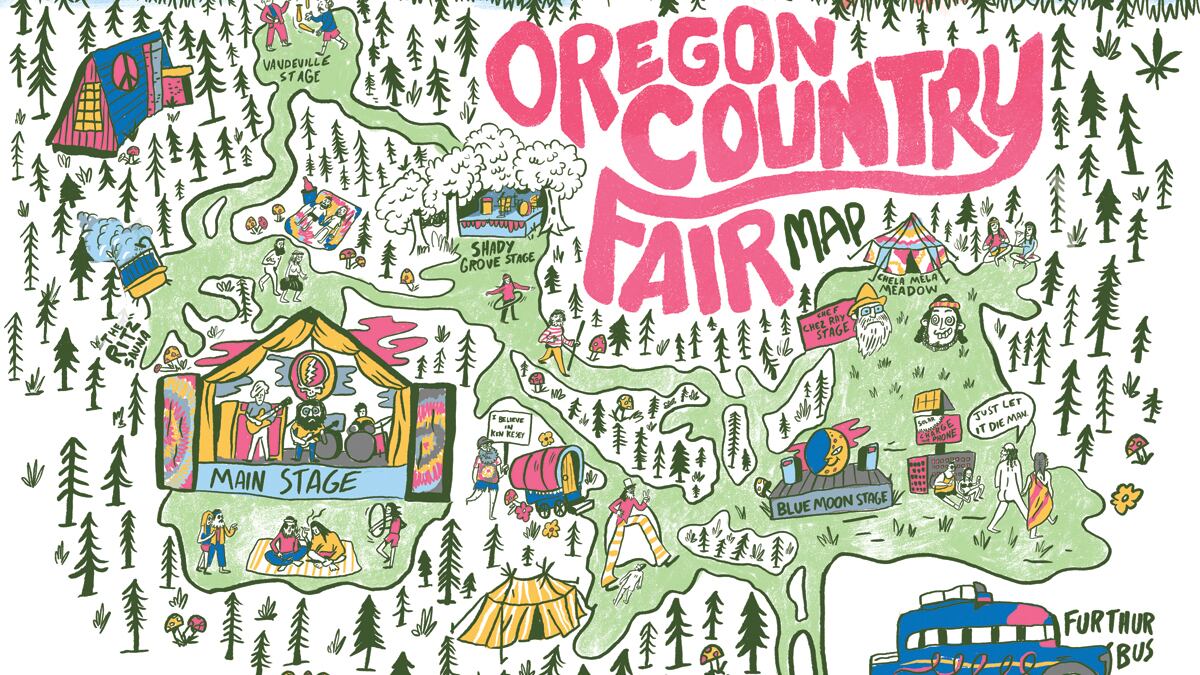The Oregon Country Fair is often billed as the epitome of hippie culture. The festival in Veneta, outside Eugene, is a confluence of 1960s values, a place where old hippies mingle with children who grew up eating honey sandwiches on wheat bread and going to school with their clothes smelling of patchouli.
At least, that's what it is for me. The Oregon Country Fair has shaped my worldview perhaps more than anything else—for better and worse. But for other people, OCF is an overrated, drug-fueled mob of dirty naked people in the forest. I get that—it's hot, it's dirty, it's druggy.
I've been to the Oregon Country Fair more times than I can count, so I made a map to show you the best places to sit down when that guy on 'shrooms won't stop trying to paint your face, along with some history to better understand the Fair.
a. Main Stage
The site of the 1972 Grateful Dead "Sunshine Daydream" show, which the Dead played as a benefit for the Kesey family's Springfield Creamery, which made a little hippie yogurt called Nancy's. Maybe you've heard of it? The benefit show is credited with saving the creamery, and is considered one of the best Grateful Dead shows of all time. It's on video, filmed by Merry Prankster Ken Babbs, who still lives outside Eugene.
b. Chela Mela Meadow
This is where all the hula hoops, juggling and parachutes happen. It's also where you go once you're full-on tripping. This is one of the only places at the Fair named after a Native American tribe that used to live on the land, the Chelamela, a tribe of the larger Kalapuya ethnic group.
c. The Path
The freeway of the Fair, which old fairgoers call "The 8." When the volunteer crews, who camp at the fairgrounds, get tired of huge mobs of people, they'll take a break from The 8 and go hang out in their campsites. During the winter, the entire fairgrounds flood. In 1994, Ken Kesey told the Paris Review,"The good guys, the real God, are hippies in tie-dyes out at the Oregon Country Fair, who are providing a sprinkle of mischief and chaos to keep things from becoming mud all over." He could have literally meant mud.
d. The Ritz Sauna and Showers
The Ritz is a group who sets up an expansive bathhouse and spa, where you can lounge next to dozens of other naked people. There's lots of castile soap and art. This year, the Ritz was under scrutiny after planning to raise a highly controversial Native American-style totem pole, which they called a "Story Pole," to honor four members of the Ritz group who were killed in a plane crash. Native Americans said this was cultural appropriation, and after a series of charged debates the fair voted to disallow the pole.
e. Blue Moon Stage
The String Cheese Incident played a set here in 1999.
f. Parking Area
Where the refurbished Furthur bus made its public debut in 2014.
g. Springfield Creamery Booth
Ken Babbs hangs out here and still gets recognized. Babbs was a Merry Prankster, along with Kesey, who traveled the country in the Furthur bus, which became the subject of Tom Wolfe's Electric Kool-Aid Acid Test.
h. The Flow Zone
This is where people come to do yoga.
i. Xavanadu
The area where nobody really goes, unless you're brand-new to the Fair. There's solar EV charging, where nu fairgoers go to charge their phones, while old-school people let them die.
j. Shady Grove Stage
When everyone around you is tripping and you can't find a place to sit, find your way to the Shady Grove Stage, under a canopy of trees and directly across from what is essentially a tiny forest with a misting hose.
The Oregon Country Fair is at 24207 OR-126, Veneta, Friday, July 7-Sunday, July 9, 11 am-7 pm. $27-30.
Related:
Members of Native American Tribes Say Oregon Country Fair's "Story Pole" Is An Abomination
No Totem Pole at Oregon Country Fair After Complaints From Native Americans

